Potřebujeme váš souhlas k využití jednotlivých dat, aby se vám mimo jiné mohly ukazovat informace týkající se vašich zájmů. Souhlas udělíte kliknutím na tlačítko „OK“.
ASTM D149-09(2013)
Standard Test Method for Dielectric Breakdown Voltage and Dielectric Strength of Solid Electrical Insulating Materials at Commercial Power Frequencies
Automaticky přeložený název:
Standardní zkušební metoda pro Dielektrická napětí a dielektrickou pevnost těles elektrických izolačních materiálů při komerční výrobě frekvencí
NORMA vydána dne 1.4.2013
Informace o normě:
Označení normy: ASTM D149-09(2013)
Poznámka: NEPLATNÁ
Datum vydání normy: 1.4.2013
Kód zboží: NS-17420
Počet stran: 13
Přibližná hmotnost: 39 g (0.09 liber)
Země: Americká technická norma
Kategorie: Technické normy ASTM
Kategorie - podobné normy:
Anotace textu normy ASTM D149-09(2013) :
Keywords:
breakdown, breakdown voltage, calibration, criteria of breakdown, dielectric breakdown voltage, dielectric failure, dielectric strength, electrodes, flashover, power frequency, process-control testing, proof testing, quality-control testing, rapid rise, research testing, sampling, slow rate-of-rise, step-by-step, surrounding medium, voltage withstand, ICS Number Code 29.035.01 (Insulating materials in general)
Doplňující informace
| Significance and Use | ||||||||||||||||||||
|
5.1 The dielectric strength of an electrical insulating material is a property of interest for any application where an electrical field will be present. In many cases the dielectric strength of a material will be the determining factor in the design of the apparatus in which it is to be used. 5.2 Tests made as specified herein are suitable for use to provide part of the information needed for determining suitability of a material for a given application; and also, for detecting changes or deviations from normal characteristics resulting from processing variables, aging conditions, or other manufacturing or environmental situations. This test method is useful for process control, acceptance or research testing. 5.3 Results obtained by this test method can seldom be used directly to determine the dielectric behavior of a material in an actual application. In most cases it is necessary that these results be evaluated by comparison with results obtained from other functional tests or from tests on other materials, or both, in order to estimate their significance for a particular material. 5.4 Three methods for voltage application are specified in Section 12: Method A, Short-Time Test; Method B, Step-by-Step Test; and Method C, Slow Rate-of-Rise Test. Method A is the most commonly-used test for quality-control tests. However, the longer-time tests, Methods B and C, which usually will give lower test results, will potentially give more meaningful results when different materials are being compared with each other. If a test set with motor-driven voltage control is available, the slow rate-of-rise test is simpler and preferable to the step-by-step test. The results obtained from Methods B and C are comparable to each other. 5.5 Documents specifying the use of this test method shall also specify: 5.5.1 Method of voltage application, 5.5.2 Voltage rate-of-rise, if slow rate-of-rise method is specified, 5.5.3 Specimen selection, preparation, and conditioning, 5.5.4 Surrounding medium and temperature during test, 5.5.5 Electrodes, 5.5.6 Wherever possible, the failure criterion of the current-sensing element, and 5.5.7 Any desired deviations from the recommended procedures as given. 5.6 If any of the requirements listed in 5.7 Unless the items listed in 5.8 Variations in the failure criteria (current setting and response time) of the current sensing element significantly affect the test results. 5.9 Appendix X1. contains a more complete discussion of the significance of dielectric strength tests. |
||||||||||||||||||||
| 1. Scope | ||||||||||||||||||||
|
1.1 This test method covers procedures for the determination of dielectric strength of solid insulating materials at commercial power frequencies, under specified conditions.1.2 Unless otherwise specified, the tests shall be made at 60 Hz. However, this test method is suitable for use at any frequency from 25 to 800 Hz. At frequencies above 800 Hz, dielectric heating is a potential problem. 1.3 This test method is intended to be used in conjunction with any ASTM standard or other document that refers to this test method. References to this document need to specify the particular options to be used (see 5.5). 1.4 It is suitable for use at various temperatures, and in any suitable gaseous or liquid surrounding medium. 1.5 This test method is not intended for measuring the dielectric strength of materials that are fluid under the conditions of test. 1.6 This test method is not intended for use in determining intrinsic dielectric strength, direct-voltage dielectric strength, or thermal failure under electrical stress (see Test Method D3151). 1.7 This test method is most commonly used to determine the dielectric breakdown voltage through the thickness of a test specimen (puncture). It is also suitable for use to determine dielectric breakdown voltage along the interface between a solid specimen and a gaseous or liquid surrounding medium (flashover). With the addition of instructions modifying Section 1.8 This test method is similar to IEC Publication 243-1. All procedures in this method are included in IEC 243-1. Differences between this method and IEC 243-1 are largely editorial. 1.9 This standard does not
purport to address all of the safety concerns, if any, associated
with its use. It is the responsibility of the user of this standard
to establish appropriate safety and health practices and determine
the applicability of regulatory limitations prior to use.
Standard Practice for Preparation of
Insulating Paper and Board Impregnated with a Liquid Dielectric Standard Specification for Mineral
Insulating Oil Used in Electrical Apparatus (Includes all
amendments and changes 1/1/2018). C68.1 Techniques for Dielectric Tests, IEEE
Standard No. 4 Available from American National Standards Institute
(ANSI), 25 W. 43rd St., 4th Floor, New York, NY 10036,
http://www.ansi.org. Pub. 243-1 Methods of Test for Electrical Strength
of Solid Insulating Materials--Part 1: Tests at Power Frequencies
Available from International Electrotechnical Commission (IEC), 3
rue de Varemb, Case postale 131, CH-1211, Geneva 20, Switzerland,
http://www.iec.ch. Standard Specification for
Forced-Convection Laboratory Ovens for Evaluation of Electrical
Insulation Standard Test Methods for Thickness of
Solid Electrical Insulation Standard Practice for Conditioning
Plastics for Testing Standard Test Method for Thermal Failure
of Solid Electrical Insulating Materials Under Electric Stress
(Withdrawn 2007) Standard Terminology Relating to
Electrical Insulation Standard Test Method for Dielectric
Breakdown Voltage of Insulating Liquids Using Disk Electrodes |
Podobné normy:
Historická
1.5.2013
Historická
1.4.2014
Historická
1.10.2006
Historická
1.10.2009
Historická
1.11.2012
Historická
1.3.2013
Doporučujeme:
Aktualizace technických norem
Chcete mít jistotu, že používáte pouze platné technické normy?
Nabízíme Vám řešení, které Vám zajistí měsíční přehled o aktuálnosti norem, které používáte.
Chcete vědět více informací? Podívejte se na tuto stránku.



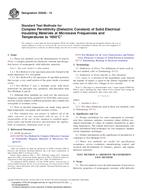 ASTM D2520-13
ASTM D2520-13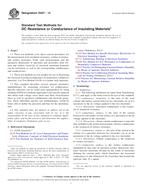 ASTM D257-14
ASTM D257-14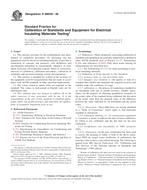 ASTM D2865M-06
ASTM D2865M-06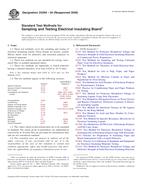 ASTM D3394-94(2009)..
ASTM D3394-94(2009)..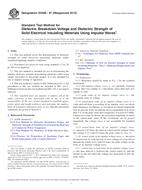 ASTM D3426-97(2012)..
ASTM D3426-97(2012)..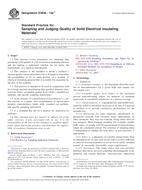 ASTM D3636-13ae1..
ASTM D3636-13ae1..
 Cookies
Cookies
